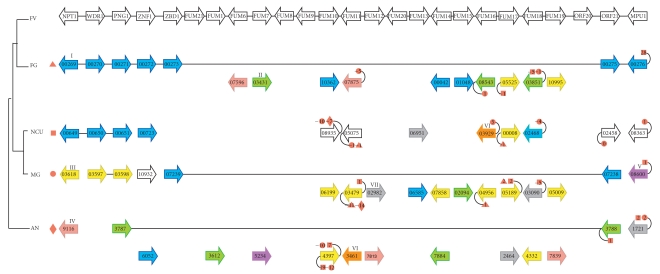Figure 1.
Representation of the fumonisin cluster and its flanking genes in F. verticillioides (FV). Columns are homologs of the FUM genes and orthologs of the flanking genes identified by phylogenetic analysis in F. graminearum (FG), N. crassa (NCU), M. grisea (MG), and A. nidulans (AN). Genes in the latter four species are identified by gene numbers from their genome projects. Different colors represent different chromosomes. The long lines in F. graminearum, M. grisea, and A. nidulans show that in those species, there is a site in the genome that corresponds to the FUM cluster location, but no FUM genes are present at that locus. Curved lines and numbers in orange symbols indicate conservation of the neighboring genes around FUM homologs in F. graminearum, N. crassa, M. grisea, and A. nidulans. For each gene show in the figure (the focal genes) we considered the two genes immediately next to it. If these genes have orthologs located <20 genes away from the focal gene's ortholog in another species, a symbol indicates this fact. For example, the numbers −10 (in a circle) and −7 (in a diamond) connected to gene NCU08935 indicate that the gene immediately after NCU08935 (i.e., NCU08936) has an ortholog in M. grisea that is 10 genes away from MG06199 (i.e., MG06189), and an ortholog in A. nidulans that is 7 genes away from AN04397 (i.e., AN04392). Triangles, squares, circles, and diamonds indicate relationships to F. graminearum, N. crassa, M. grisea, and A. nidulans, respectively.

